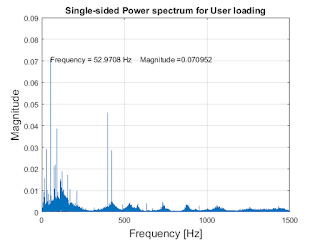Contents
Matlab Code:
Author: Minh Anh Nguyen (
minhanhnguyen@q.com) This script will perform the following tasks:
close all;
clear all;
clc;
fontSize = 20;
fontSize1 = 14;
fontSize2 = 12;
folder = 'C:\Users\Minh anh\Desktop\microphone-project-demo';
sound1=audioread('.\good 2.wav');
[y1,fs1]=audioread('.\good 2.wav');
sound2=audioread('.\good 3.wav');
[y2,fs2]=audioread('.\good 3.wav');
sound1_baseline_noise=audioread('.\good 2_noise.wav');
[y1_basenoise,fs1_basenoise]=audioread('.\good 2_noise.wav');
sound2_baseline_noise=audioread('.\good 3_noise.wav');
[y2_basenoise,fs2_basenoise]=audioread('.\good 3_noise.wav');
signal into left and right, stereo records
size(y1);
left1=y1(:,1);
right1=y1(:,2);
[MR1,NR1] = size(right1);
size(y2);
left2=y2(:,1);
right2=y2(:,2);
[MR2,NR2] = size(right2);
time for right signal only (stereo) for original signals
Nl = length(right1);
lsl = size (right1);
nbits = 2^(length(right1));
t1l = (0:1:length(right1)-1)/fs1;
fx = fs1*(0:Nl/2-1)/Nl;
T1 = 1/fs1;
N = Nl;
N2 = length(right2);
ls2 = size (right2);
nbits2 = 2^(length(right2));
t2 = (0:1:length(right2)-1)/fs2;
fx2 = fs2*(0:N2/2-1)/N2;
T2 = 1/fs2;
size(y1_basenoise);
left1_basenoise=y1_basenoise(:,1);
right1_basenoise=y1_basenoise(:,2);
[MR1_basenoise,NR1_basenoise] = size(right1_basenoise);
size(y2_basenoise);
left2_basenoise=y2_basenoise(:,1);
right2_basenoise=y2_basenoise(:,2);
[MR2_basenoise,NR2_basenoise] = size(right2_basenoise);
t1_basenoise = (0:1:length(right1_basenoise)-1)/fs1_basenoise;
t2_basenoise = (0:1:length(right2_basenoise)-1)/fs2_basenoise;
voice1 = right1(fs1*1 : fs1*40);
voice2 = right2(fs2*1 : fs2*40);
find new length
N2x = length(voice2);
N1x = length(voice1);
find new time
t1x = (0:1:length(voice1)-1)/fs1;
t2x = (0:1:length(voice2)-1)/fs2;
find new frequency
f2x = fs2*(0:N2x/2-1)/N2x;
f1x = fs1*(0:N1x/2-1)/N1x;
perform fft and plot of the cut orignal signal
NFFT1x = 2 ^ nextpow2(N1x);
Y1x = fft(voice1, NFFT1x)/ N1x;
f1xx = (fs1/ 2 * linspace(0, 1, NFFT1x / 2+1))';
STFFT1x = ( 2 * abs(Y1x(1: NFFT1x / 2+1)));
NFFT2x = 2 ^ nextpow2(N2x);
Y2x = fft(voice2, NFFT2x) / N2x;
f2xx = (fs2 / 2 * linspace(0, 1, NFFT2x / 2+1))';
STFFT2x = ( 2 * abs(Y2x(1: NFFT2x / 2+1)));
figure; subplot (2,2,1); plot(t1x, voice1);xlim([0,40]); ylim([-2,2]);
str1=sprintf('Correct loading signal');
title(str1,'Fontsize', fontSize2);
xlabel('Time (sec)','Fontsize', fontSize1); ylabel('Amplitude','Fontsize', fontSize1); grid on;
subplot (2,2,2); plot(t2x, voice2); xlim([0,40]); ylim([-2,2]);
str2=sprintf('User loading signal');
title(str2,'Fontsize', fontSize2); xlabel('Time (sec)','Fontsize', fontSize1); ylabel('Amplitude','Fontsize', fontSize1); grid on;
figure;
plot(f1xx, STFFT1x); xlim([0,1500]); ylim([0,.09]);
str1ft1=sprintf('Single-sided Power spectrum for Correct loading');
title(str1ft1,'Fontsize', fontSize2);
ylabel ('Magnitude','Fontsize', fontSize1); xlabel ('Frequency [Hz]','Fontsize', fontSize1); grid on;
indexmin1 = find(min(STFFT1x) == STFFT1x);
xmin1 = f1xx(indexmin1);
ymin1 = STFFT1x(indexmin1);
indexmax1 = find(max(STFFT1x) == STFFT1x);
xmax1 = f1xx(indexmax1);
ymax1 = STFFT1x(indexmax1);
strmax1 = ['Frequency = ',num2str(xmax1),' Hz',' ','Magnitude=', num2str(ymax1),''];
text(xmax1,ymax1,strmax1,'HorizontalAlignment','Left');
figure; plot(f2xx, STFFT2x); xlim([0,1500]); ylim([0,.09]);
str1ft2=sprintf('Single-sided Power spectrum for User loading');
title(str1ft2,'Fontsize', fontSize2);
ylabel ('Magnitude', 'Fontsize', fontSize1); xlabel ('Frequency [Hz]','Fontsize', fontSize1); grid on;
indexmin2 = find(min(STFFT2x) == STFFT2x);
xmin2 = f2xx(indexmin2);
ymin2 = STFFT2x(indexmin2);
indexmax2 = find(max(STFFT2x) == STFFT2x);
xmax2 = f2xx(indexmax2);
ymax2 = STFFT2x(indexmax2);
strmax2 = ['Frequency = ',num2str(xmax2),' Hz',' ','Magnitude =', num2str(ymax2),' '];
text(xmax2,ymax2,strmax2,'HorizontalAlignment','Left');



Zoom in to signal baseline noise signal
figure; subplot(3,2,1); plot(t1_basenoise,right1_basenoise); xlim([0,10]); ylim([-2,2]);
str1=sprintf('Correct loading with Zoom in');
title(str1,'Fontsize', fontSize1);
xlabel('Time (secs)','Fontsize', fontSize1); ylabel('Amplitude','Fontsize', fontSize1); grid on;
subplot(3,2,3); plot(t2_basenoise,right2_basenoise,'r'); xlim([0,10]); ylim([-2,2]);
str2=sprintf('User loading with Zoom in');
title(str2, 'Fontsize', fontSize1);
xlabel('Time (secs)','Fontsize', fontSize1); ylabel('Amplitude','Fontsize', fontSize1); grid on;
plot two signals
figure, plot(t1_basenoise,right1_basenoise, t2_basenoise,right2_basenoise,'r'); xlim([0,10]); ylim([-2,2]);
str2=sprintf('Comparing two loading signals with Zoom in ');
title(str2, 'Fontsize', fontSize1);
xlabel('Time (secs)','Fontsize', fontSize1); ylabel('Amplitude','Fontsize', fontSize1); grid on;
legend ('Correct loading signal', 'User loading signal', 'Fontsize', fontSize);
Warning: Using an integer to specify the legend location is not supported.
Specify the legend location with respect to the axes using the 'Location'
parameter.
Warning: Ignoring extra legend entries.
plot fft compare
figure, plot(f1xx, STFFT1x,f2xx, STFFT2x,'r'); xlim([0,1500]); ylim([0,.09]);
str1ft3=sprintf('Comparing FFT for two loading signals');
title(str1ft3,'Fontsize', fontSize1);
ylabel ('Magnitude', 'Fontsize', fontSize1); xlabel ('Frequency [Hz]','Fontsize', fontSize1); grid on;
indexmax3 = find(max(STFFT2x) == STFFT2x);
xmax3 = f2xx(indexmax3);
ymax3 = STFFT2x(indexmax3);
strmax3 = ['Frequency = ',num2str(xmax3),' Hz',' ','Magnitude= ', num2str(ymax3),' '];
legend ('Correct loading signal', 'User loading signal','Fontsize', fontSize);
Warning: Using an integer to specify the legend location is not supported.
Specify the legend location with respect to the axes using the 'Location'
parameter.
Warning: Ignoring extra legend entries.
calculate and compare two signals
Calculate the MSE
D= voice1 - voice2;
MSE=mean(D.^2);
if MSE <= 5.2731e-09 ;
disp('Signal are the same');
else
disp('Signal are not the same');
msgbox('Centrifuge loading error. Please check bearings are seated properly');
end
D1c= STFFT1x - STFFT2x;
MSEfft=mean(D1c.^2);
disp(['MSEfft' num2str(MSEfft)]);
mean1= sum(right1)/N;
mean2= sum(right2)/N2;
stdev1 = sqrt ((sum(right1-mean1).^2)/2);
stdev2 = sqrt ((sum(right2-mean2).^2)/2);
var(voice1(1:length(voice2))-voice2);
fprintf('digital statitics of voice 1 a same length signal\n\n');
fprintf('mean of voice 1:%f\n', mean(voice1));
fprintf('standard deviation of voice 1:%f\n', std(voice1));
fprintf('variance of voice 1:%f\n', std(voice1)^2);
fprintf('average power of voice 1:%f\n', mean(voice1.^2));
fprintf('average magnitude of voice 1:%f\n', mean(abs(voice1)));
fprintf('\ndigital statitics of voice 2\n\n');
fprintf('mean of voice 2:%f\n', mean(voice2));
fprintf('standard deviation of voice 2:%f\n', std(voice2));
fprintf('variance of voice 2:%f\n', std(voice2)^2);
fprintf('average power of voice 2:%f\n', mean(voice2.^2));
fprintf('average magnitude of voice 2:%f\n', mean(abs(voice2)));
Signal are the same
MSEfft0
digital statitics of voice 1 a same length signal
mean of voice 1:-0.000105
standard deviation of voice 1:0.251742
variance of voice 1:0.063374
average power of voice 1:0.063374
average magnitude of voice 1:0.197595
digital statitics of voice 2
mean of voice 2:-0.000105
standard deviation of voice 2:0.251742
variance of voice 2:0.063374
average power of voice 2:0.063374
average magnitude of voice 2:0.197595
correlation
[C1, lag1] = xcorr(abs((fft(voice1))),abs((fft(voice2)) ));
figure, plot(lag1/fs1,C1);
ylabel('Amplitude'); grid on
title('Cross-correlation between Correct and User loading files')







No comments:
Post a Comment